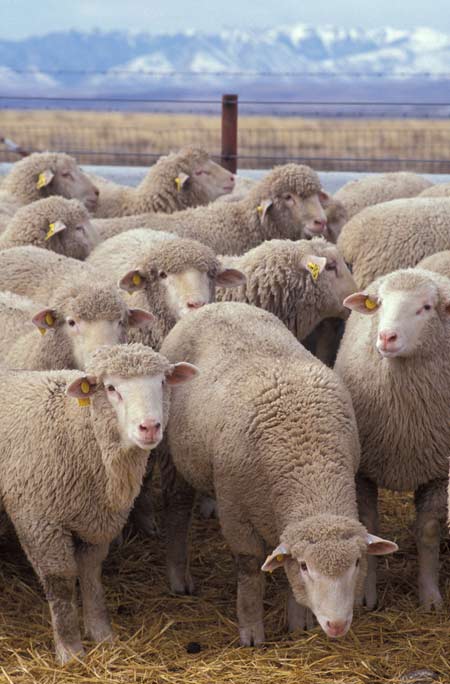The Offbeat Science of Collecting Animal Semen

Wild or domesticated, sex is rampant in the animal world. But sometimes animals can't do it, don't want to, or there just aren't enough of them left to guarantee survival of the species.
That's when the semen experts step in.
Collecting semen and the sperm cells it contains is common practice with livestock. And semen from a first-rate bull or show dog fetches a high price from breeders aiming to breed top-quality animals.
Gathering the goods is done by employing female decoys, an electric device, or an even less romantic process that gets the scientists highly involved. More on that in a minute.
Protection required
In one of the latest efforts, researchers at the United States Department of Agriculture (USDA) are collecting semen from a dwindling population of sheep. They are taking this precautionary measure in case the sheep become extinct and need to be reintroduced.
Spanish missionaries introduced the Navajo Churro sheep to the southwestern United States 500 years ago. Because it fared well in the dry climate, produced more lambs than the average sheep, and grew premium wool, the Navajo people adopted the sheep as an important part of their culture.
Sign up for the Live Science daily newsletter now
Get the world’s most fascinating discoveries delivered straight to your inbox.
Hand-spinners prefer Churro wool for making blankets, but it has relatively low value as industrial wool. People - and their money - convinced the Navajo to raise other breeds of sheep. Once upon a time there were two million Churro sheep. A 1977 survey counted only 500, prompting a conservation effort. That effort has raised the number to 1500, but the population is still considered at risk.
"The Navajo Churro has been designated as a rare breed by the American Livestock Breeds Conservancy," Harvey Blackburn of the USDA's Agricultural Research Services told LiveScience. "Such a designation gives us a warning that actions need to be taken to develop a security backup for the breed."
How it's done
Collecting semen is a tricky business. Breeders and geneticists generally use one of three standard methods.
In one approach, the male is aroused by either a teaser female or a decoy animal. As it tries to mount the female, breeders discreetly direct things into an artificial latex collection reservoir.
Another method, called electroejaculation, applies mild electrical stimulation to the accessory sex glands and allows breeders to collect a sample without a female, or decoy, present.
With some species a more, well, hands-on approach is required of the breeder. Here's how the American Society of Andrology puts it:
"With boars and dogs, the male is allowed to mount an estrous female or phantom and the collector [person] simply grasps the free end of the protruded penis to mimic the spiral interior of the cervix of the female pig or the encircling vaginal vestibular muscles of the female dog, and masturbates the male."
However it's obtained, the sample is slowly cooled to preserve the morphology of the sperm cells. The samples are then frozen.
Widespread practice
Brazil, France, and The Netherlands all have similar collections for domestic livestock.
One of the more impressive collection is the Frozen Zoo at the Audubon's Center for Research of Endangered Species (ACRES). The New Orleans-based project has frozen the sex cells from a wide array of endangered and at-risk animals, including gorillas, Sumatran tigers, jaguars, Jabiru storks, mountain bongo antelopes, African and Asian elephants, Baird's tapirs, colobus monkeys, lions, black bears, and Thompson gazelles to name a few.
The San Diego Zoo also has a frozen section. It contains samples of 1,040 animals representing 280 species.
Semen collecting can also be rooted in commercial interests. The North American Germplasm Program (NAGP) has determined that collections are needed for all commercially important breeds.
"We have semen from cattle, sheep, goats, swine, chickens, and approximately 10 aquatic species," Blackburn said. All of these animals are important sources for either food or fiber.
While most of these animals are not in danger of becoming extinct anytime soon, the NAGP wants to be prepared if some catastrophe were to strike. Another reason for collecting semen from these species is to inject genetic diversity into a population later on.
The other half of the equation -- impregnating females -- has become rather routine but is not often an easy task. Just ask the scientists who inseminated a whale (with the aid of a crane), or those who helped an elephant get pregnant (a wheelbarrow was involved).
Half the equation
Blackburn set out to collect 6,000 units of Churro sheep semen. So far he has 1,200 samples from 27 different rams. He would like to increase that latter number to at least 50 to broaden genetic diversity within the collection.
Currently Blackburn is collecting only semen. To gather eggs or embryos "is more complicated, requires more time and financial resources."
Should the situation ever arise where the Churro needs to be totally regenerated, scientists would use a method called backcrossing. Breeders would inseminate a ewe of a different sheep breed with Churro semen from the bank.
Offspring from this first cross would be 50 percent Churro. Inseminating a half-and-half ewe with Churro semen would produce a lamb that is 75 percent Churro. This process would be repeated until the sheep are 93 percent Churro.
Blackburn's efforts were published in the April issue of Agricultural Research magazine.
Related Stories
- Survival Skills: Why Sex is Good
- Scientists Aim to Revive the Woolly Mammoth
- Sex Done, Female Fish Stop Paying Attention
- Well-fed Crickets Seek Sex Incessantly, Die Young
- Biodiversity Declining at 'Unprecedented Rate'
Killer Idea

Image Credit: SeaWorld, the National Zoological Park, and the Zoological Society of San Diego
Hey, What about Me?










